Ice houses keep food cold year-round by combining smart design with nature's cooling power. You'll find most ice houses built underground, where the earth maintains a stable 50-60°F temperature. They use thick double walls filled with insulating materials like sawdust or modern foam, while their rounded shapes minimize heat exposure. Strategic ventilation systems and proper drainage prevent moisture buildup, keeping humidity levels perfect for food preservation. When packed correctly with harvested ice blocks and natural insulation, these structures can maintain freezing temperatures for over a year. These time-tested techniques offer fascinating insights into sustainable food storage without electricity.
Ancient Origins of Ice Storage
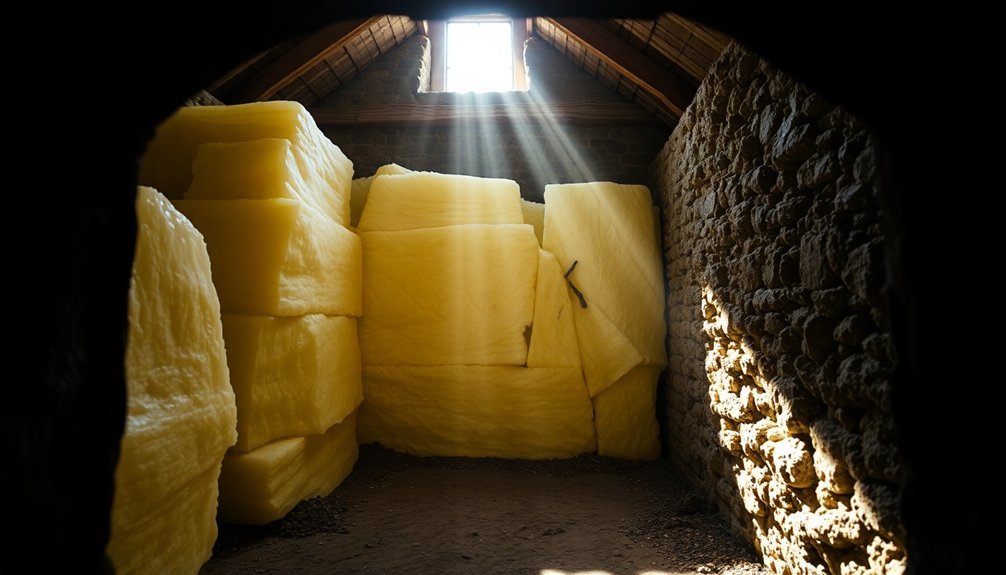
The quest to keep food cold dates back thousands of years. As early as 1750 B.C.E., you'd find ice houses along the Euphrates River in Mesopotamia, where people stored winter ice for summer use. The ancient civilizations developed remarkably innovative methods to preserve their food and cool their beverages.
In Persia, you'll find evidence of sophisticated engineering in the form of Yakhchāl structures from around 400 B.C.E. These buildings used specialized mortar and underground storage to keep ice frozen even during scorching summers.
The Chinese mastered their own techniques by 700 B.C.E., using ice pits and copper boxes with strategic holes to maintain cool temperatures for fruits and other perishables. By 1000 BCE, they had advanced to harvesting ice blocks from streams to preserve their food supplies.
You might be surprised to learn that the Egyptians and Indians discovered how to create ice through evaporative cooling. By placing water in clay pots on beds of straw, they could achieve freezing temperatures on cold nights.
Even the Greeks and Romans got involved in the ice trade, with Alexander the Great constructing Greece's first icehouse and wealthy Romans having snow transported from mountains to cool their drinks.
Underground Construction Benefits
Underground construction gives you significant advantages when storing ice, as the earth naturally provides consistent cooling and temperature regulation throughout the year.
You'll find that building an icehouse below ground level creates a stable environment that's less affected by surface temperature fluctuations and seasonal changes.
Your ice storage also gains protection from harsh weather elements like direct sunlight, wind, and rain, which helps maintain the cold temperatures needed for preservation.
Early icehouses utilized wood-lined underground structures to maximize these natural cooling benefits.
Earth's Natural Cooling Effect
Nearly all effective natural cooling systems draw inspiration from Earth's remarkable temperature-regulating properties. When you dig below the surface, you'll find that ground temperatures remain surprisingly constant throughout the year, creating a natural heat sink in summer and a heat source in winter. This consistent temperature serves as the foundation for energy-efficient cooling methods. Underground temperatures typically stay between 50-60 degrees Fahrenheit, making them ideal for temperature regulation.
You can harness this natural cooling effect through underground construction techniques that utilize the earth's stable temperature. By implementing systems like earth tubes or air tunnels, you'll benefit from pre-conditioned air that's naturally cooled or warmed as it passes through underground passages.
These systems not only filter out pollutants and control humidity but also reduce your reliance on conventional HVAC equipment.
The energy savings are substantial – you can expect to cut your energy consumption by 15-20% when you tap into the earth's cooling properties. This approach mirrors the wisdom found in historical structures like traditional icehouses, which used underground chambers insulated with materials like sawdust to preserve ice.
Today's modern applications continue to prove that working with, rather than against, the earth's natural temperature regulation is both cost-effective and environmentally sound.
Stable Temperature Environment
Maintaining a stable temperature environment becomes remarkably efficient when you build storage structures underground. Just a few meters below the surface, you'll find that soil temperatures consistently hover between 45-52°F (7-11°C) throughout the year. This natural stability comes from the earth's massive thermal mass, which resists temperature changes due to its density and volume.
When you construct an ice house underground, you're taking advantage of this natural phenomenon. The deeper you go (beyond 2 meters), the less external weather conditions affect the internal temperature. You'll notice that this stable environment requires considerably less energy to maintain cold storage temperatures compared to above-ground structures. It's particularly effective when you're aiming for the ideal food storage conditions of 32-40°F (0-4°C).
The underground environment also helps maintain ideal humidity levels between 85-95%, which is essential for preserving perishable items. You can enhance this natural stability through strategic design choices, such as proper ventilation systems and insulation materials.
When you combine these construction elements with the earth's natural temperature regulation, you'll create an efficient, reliable cold storage solution that works year-round.
Protection From Weather Elements
Building ice houses below ground level offers remarkable protection from harsh weather elements. When you construct an ice house underground, you're utilizing the earth's natural insulating properties to maintain consistent cold temperatures throughout the year. The soil acts as a barrier against external temperature fluctuations, while also shielding the structure from direct sunlight and strong winds.
You'll find that underground construction provides several key advantages. Deep foundations filled with cobblestones help drain away water and prevent frost heaving, which could otherwise compromise the structure's integrity. The below-ground placement naturally reduces exposure to warm air and sunlight, two primary factors that could cause ice to melt.
To enhance this protection further, you'll want to incorporate proper aeration and drainage systems under the foundation. These features are essential for maintaining the cold environment while preventing moisture-related issues.
The underground setting also allows for more effective use of double-wall construction and insulation materials like sawdust or straw mats. When combined with features like antechambers and double-insulated doors, you're creating a highly efficient system that protects stored ice from external weather conditions year-round.
Nature's Cooling Power
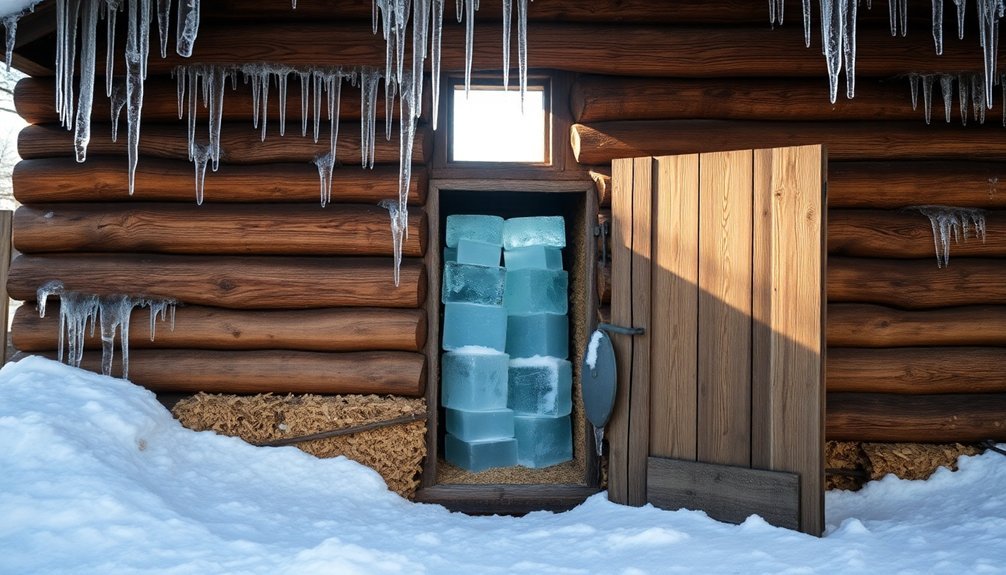
You'll find that nature provides remarkable cooling abilities through the earth's natural insulation, making underground storage an ideal choice for ice houses.
When you store ice during winter months, you can maintain these frigid temperatures deep beneath the surface through strategic packing methods and proper drainage systems.
The careful architectural design of ice houses takes advantage of these natural cooling properties, incorporating features like thick walls, domed roofs, and ventilation systems to maintain consistently cold temperatures year-round.
Underground Earth's Natural Insulation
Deep beneath the Earth's surface lies a remarkable natural cooling system that has fascinated engineers and architects for centuries. When you dig about 10 feet underground, you'll find a consistent temperature that reflects your region's annual mean, thanks to the Earth's impressive thermal mass properties.
The soil and rock beneath your feet act as a natural thermal reservoir, creating what's known as thermal inertia. This means temperature changes happen extremely slowly underground – about one-tenth of a degree per day.
You'll notice a three-to-six-month thermal lag, which explains why underground spaces stay cool in summer and warm in winter.
While earth isn't the best insulator by itself (with just an R-value of 5 per foot), it's incredibly effective at maintaining steady temperatures over large distances. That's why ice houses built underground work so efficiently – they're tapping into nature's own temperature control system.
The earth surrounding these structures provides natural sound insulation and creates a stable microclimate that doesn't fluctuate dramatically with surface weather changes. This natural phenomenon considerably reduces the need for artificial cooling, making underground ice houses remarkably energy-efficient storage solutions.
Winter Ice Storage Methods
While underground storage provides natural insulation, the success of ice houses largely depends on how effectively winter's ice is harvested and stored. You'll find that the most efficient harvesting occurs in the early morning when temperatures drop below freezing, as workers cut large blocks from frozen lakes, rivers, and ponds.
To preserve the ice through warmer months, you'll need to pack the blocks with insulating materials like straw or sawdust. Commercial ice houses can store up to 2,700 tonnes of ice, ensuring year-round availability.
If you're considering making your own ice, you can use frost-free hydrants and drip irrigation systems to fill bins during cold winter nights when temperatures fall below 5 degrees F.
For ideal cooling in your root cellar, you should dedicate about one-third of the space to ice storage. You'll want to install proper drainage systems to manage melt water and maintain temperatures around 37 degrees F throughout summer.
This method's particularly efficient for commercial vegetable operations, as they can repurpose unused bins for ice production during winter months, creating a sustainable cooling system that doesn't rely on electricity.
Temperature Control Through Design
Nature's remarkable cooling principles come to life in ice house design through carefully planned layers of insulation and strategic structural elements. You'll find thick layers of materials like styrofoam, perlite, and cork sandwiched between inner and outer walls, creating an effective barrier against heat.
The structure's foundation starts with a concrete pad topped with insulation, while double roofs work together to shield the ice from the sun's intense heat.
- Deep ground pits lined with clay, sand, and straw provide natural insulation
- Double-wall construction with wide cavity spaces maximizes insulation efficiency
- Dome-shaped roofs with inner and outer layers prevent heat penetration
- Wrap-around porches create essential shade barriers
You're able to maintain consistently cold temperatures through smart drainage systems that prevent dampness from compromising the ice.
By elevating the ice on wooden platforms, you'll allow water to drain away effectively. The design guarantees proper ventilation between the sun roof and inner roof, preventing heat buildup while maintaining the cold environment.
Through these architectural features, you're able to harness nature's cooling power and keep food preserved throughout the year.
Insulation Materials Through History
Throughout history, people have creatively used various materials to keep ice houses cold, starting with simple yet effective natural insulators.
You'll find that early ice houses relied on readily available materials like sawdust, straw, and even seaweed to fill spaces between walls and cover ice blocks. Some innovative designs even incorporated corn husks and fur for additional insulation.
A significant advancement came with the introduction of cork insulation. While granulated cork was expensive and hard to obtain, the 1891 discovery of expanded insulation cork revolutionized the industry.
You'll see how this lighter, more effective material found its way into various applications beyond ice houses, including submarines and space exploration.
Modern ice houses now utilize advanced materials like styrofoam, typically installed 12 inches thick, along with perlite, volcanic pumice, and rock wool.
You'll notice that today's designs often combine traditional and modern approaches, featuring double roofs for ventilation and cobblestone foundations for drainage.
Many ice houses still benefit from natural cooling methods, such as strategically planted shade trees that can reduce temperatures by up to 20 degrees Fahrenheit, while insulated doors maintain the cold environment inside.
Ice Harvesting Methods
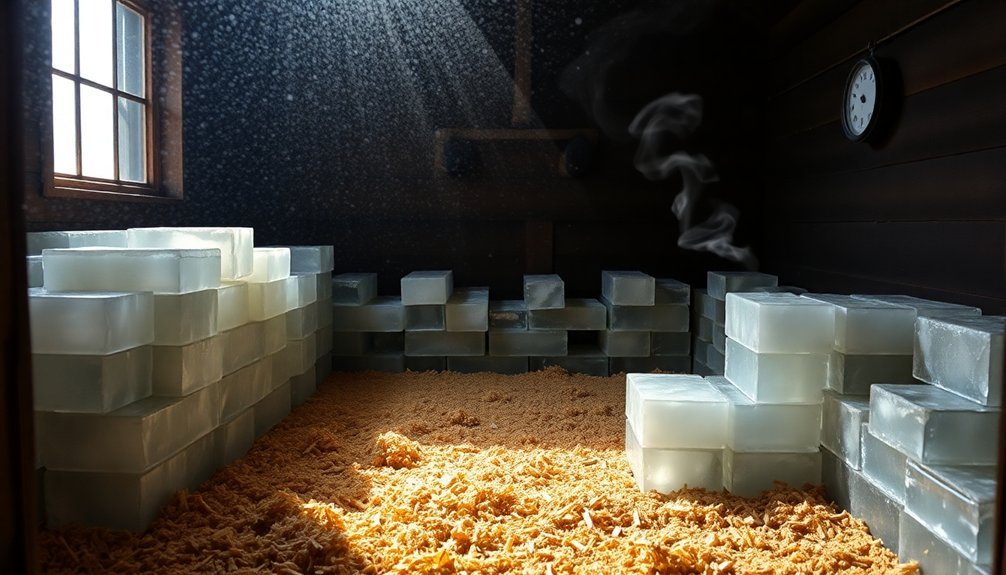
To harvest ice in winter, you'll need specialized tools like horse-drawn ice plows to mark cutting lines and long-toothed saws that cut on the downstroke to slice through thick ice sheets.
The ice blocks, typically measuring 22 by 32 inches and weighing over 280 pounds, are cut to leave a thin connecting layer that workers can easily break apart.
You'll find that successful ice harvesting often brings entire communities together, with teams of workers and horses coordinating to float the massive blocks through channels before hauling them to nearby ice houses.
Equipment and Cutting Techniques
During the heyday of ice harvesting, workers relied on specialized equipment and precise cutting methods to transform frozen lakes into manageable blocks of ice.
You'll find that before any cutting could begin, workers needed to clear snow from the surface and guarantee the ice was thick enough to support both men and horses. They'd outfit their horses with special "sharp-shod" horseshoes to prevent dangerous slips.
- Horse-drawn ice markers would first score lines several inches deep into the frozen surface.
- Workers would follow with hand saws or cross-cut saws to make the initial cuts through the ice's full thickness.
- Parallel grooves were cut using horse-drawn ice plows or circular saws.
- Ice blocks were typically cut to standard sizes: 22" x 22" or 32" x 22".
Once cut, workers would create channels through the ice to float the blocks to collection points.
You'd see them using ice tongs, hooks, and pitchforks to guide these massive blocks, which could weigh up to 400 pounds each.
Steam-powered conveyors would then lift the ice from the water, where it'd be loaded onto horse-drawn wagons for transport to the icehouse.
Community Ice Gathering Methods
Ice harvesting brought entire communities together in a carefully orchestrated process that began each January when lakes and ponds froze at least a foot thick.
Before work could begin, you'd need to clear snow from the surface to guarantee even freezing and test that the ice could support both workers and horses.
You'll find that successful ice harvesting relied on precise steps and safety measures. First, you'd mark the ice field using a horse-drawn ice marker. Your horses would need special shoes to prevent slipping, and you'd outfit them with rescue ropes in case they fell through.
Once cut, you'd float the ice blocks through channels, though you'd have to maintain these passages constantly as they'd often freeze overnight.
To move the blocks, you'd use sharp-hooked tongs, long pitchforks, or ice hooks. In smaller operations, you'd load the blocks onto horse-drawn wagons or sleds.
Larger commercial operations might employ steam-powered conveyor systems to lift ice from the water. You'd then transport the ice to storage facilities, where it would be packed in straw and sawdust to preserve it for distribution throughout the year.
The Science Behind Ice Houses
The humble ice house operates on surprisingly sophisticated scientific principles that combine insulation, natural cooling, and strategic design. When you understand the science, you'll see how these structures maintain cold temperatures through multiple integrated systems working together.
- Double-wall construction with 12-inch cavities filled with materials like styrofoam or perlite creates a powerful thermal barrier against outside heat.
- Below-grade construction at 15 feet deep naturally maintains temperatures between 50-55°F year-round.
- Round designs minimize surface area exposure to warm air and sunlight, reducing heat absorption.
- Double roof systems with 3-foot spacing enable rapid ventilation and prevent solar heat buildup.
You'll find the most effective ice houses use layered defense against warming. The foundation starts with 8 inches of styrofoam insulation under concrete, while cobblestone underlayment provides essential drainage and cooling.
The walls employ natural insulators like sawdust or straw packed between inner and outer surfaces. Even the doorways feature double-insulated designs using cork or balsa wood.
When combined with proper ice block storage techniques and regular maintenance to prevent insulation gaps, these scientific principles enable ice houses to maintain cold temperatures efficiently throughout the year.
Community Ice Storage Practices
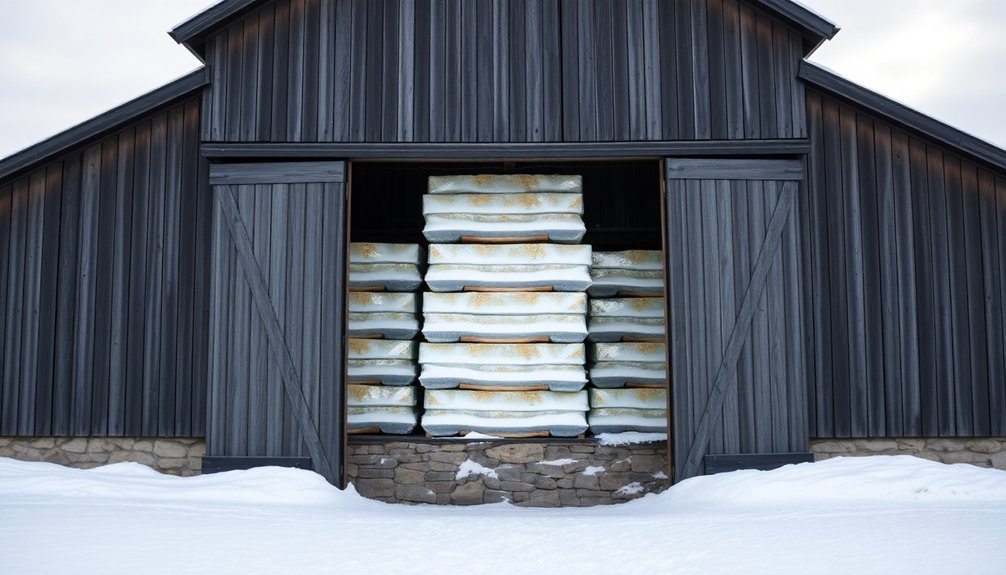
Successful community ice storage depends on rigorous hygiene protocols and smart management practices.
You'll need to maintain proper handling procedures, starting with designated scoops that are stored outside the ice bin and regularly sanitized. Never use gloved hands or glassware with the scoop, and guarantee all employees wash their hands before accessing the ice.
For effective community storage, you'll want to pack ice solidly into your icehouse, minimizing air gaps that can accelerate melting.
When you're building or maintaining an ice storage facility, proper insulation is essential – materials like straw mats or sawdust help protect the ice from sun exposure and drafts. With the right insulation, your stored ice can last over a year without electricity.
You must keep your storage areas clean using specific bleach solutions: 8 ounces per gallon for thorough cleaning, and 2 tablespoons per gallon for sanitizing.
Don't forget to implement proper drainage systems to prevent dampness from compromising your ice supply.
For commercial operations, you'll need to organize your storage so that ice blocks can be easily accessed and delivered throughout warm seasons, maintaining consistent temperature control throughout the facility.
Temperature Control Techniques
Beyond basic storage practices, modern ice houses employ sophisticated thermal energy storage techniques to maintain ideal temperatures. They've perfected the use of water's heat of fusion properties, creating ice during off-peak hours when energy costs are lower.
You'll find that this strategic approach allows for precise temperature control while maximizing efficiency.
- Create ice using glycol solutions cooled to 20°F-22°F (-6.7°C—5.6°C)
- Maintain cooling fluid temperatures as low as 34°F (1.1°C) using external melt systems
- Achieve temperature differentials of 18°F to 20°F in distribution loops
- Reduce required air and water flow through smaller pipes and ductwork
You can see two primary methods at work in modern ice houses: external and internal melt systems.
External melt systems give you more flexibility in controlling ice melt rates and no restrictions on ice water flow. They're particularly effective when you need to adjust cooling requirements throughout the day.
Internal melt systems, while offering simpler controls, work by melting ice from inside the coil ring using returning glycol solution.
This strategic approach to temperature control means you'll get consistent cooling while using about 60% less chiller capacity than conventional systems.
Seasonal Storage Solutions
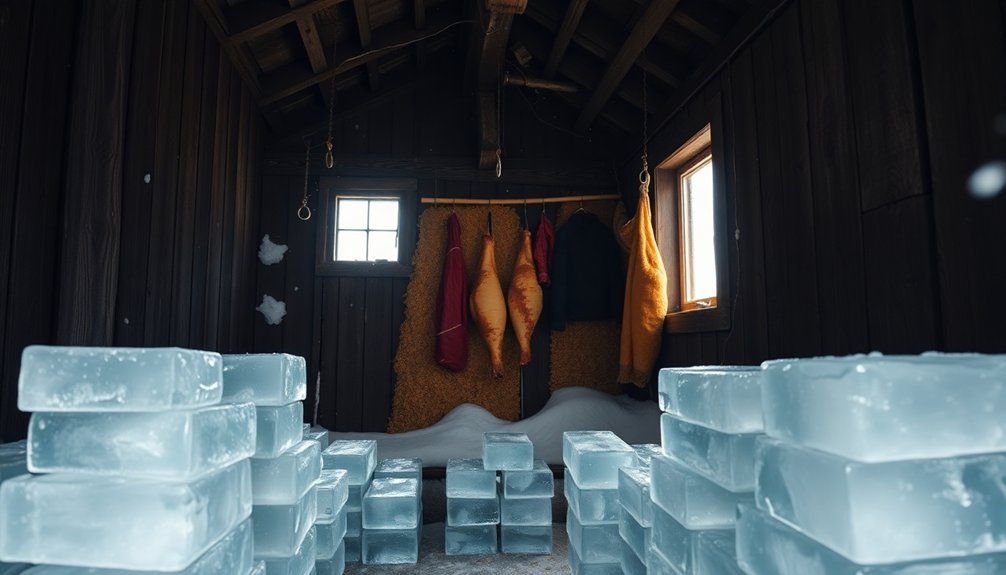
Managing seasonal food storage effectively requires a well-planned approach to ice harvesting and preservation. You'll need to start by harvesting ice during winter months when blocks can reach 300 pounds, making the most of nature's freezing temperatures. These blocks are then strategically stored in your icehouse, packed tightly with insulating materials like straw or sawdust.
| Season | Storage Activity | Food Preservation |
|---|---|---|
| Winter | Ice harvesting, block cutting | Fresh meat storage |
| Spring | Maintaining insulation layers | Dairy preservation |
| Summer | Regular ice block monitoring | Produce cooling |
To maximize your year-round storage capabilities, you'll want to combine your icehouse with other preservation methods. The below-ground construction helps maintain consistent temperatures, while proper drainage systems prevent excess moisture from compromising your stored food. You can store harvested produce, meats, and dairy products throughout the year without relying on electricity. The key is to pack ice blocks tightly, minimizing air gaps that could speed up melting. With proper management, your icehouse can maintain frozen conditions for over a year, providing a sustainable solution for long-term food preservation.
Design Elements for Maximum Efficiency
Designing an efficient ice house requires careful attention to four critical elements: insulation, ventilation, drainage, and structural layout. You'll need multiple layers of protection, including at least 12 inches of insulation materials like styrofoam, perlite, or cork in the walls, floors, and ceiling. The structure should sit 15 feet below grade to maintain a consistent temperature between 50-55°F year-round.
- Double-walled construction with wide insulation-filled cavities prevents heat penetration.
- Dual roofing system with an outer sun shield and inner weather-proof layer enhances cooling.
- Strategic vent placement near the roof and sides guarantees continuous air circulation.
- Round design minimizes surface exposure to sunlight and warm air.
You'll want to incorporate proper drainage features to prevent ice from sitting in water. This includes using cobblestone foundations and round river rocks instead of crushed stone.
Double doors help maintain interior temperatures, while wrap-around porches or natural shade from trees provide additional protection from sunlight. The foundation should include a concrete pad with 8 inches of styrofoam insulation underneath, guaranteeing minimal heat transfer from the ground.
Ice House Construction Materials
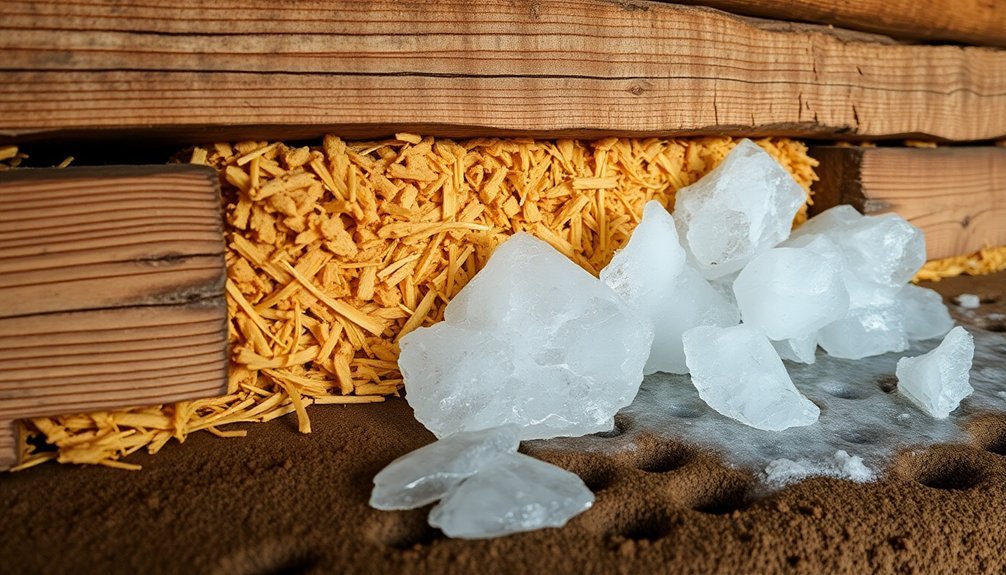
The construction of a successful ice house depends heavily on choosing the right materials for each component. You'll need sturdy lumber and wooden joists to create the basic frame, along with plywood or tongue-and-groove boards for the walls. The frame's strength comes from 6 x 4-inch joists lined with rough boarding, while wood shavings or small blocks fill the floor space.
For insulation, you'll want to combine multiple materials strategically. Install foam board or fiberglass in the wall cavities, and use wet tan or sawdust between double partitions. Straw mats help protect the ice from sun exposure and drafts, while dry tan or sawdust insulates the upper floor. You'll need expandable spray foam to seal any joints in Styrofoam blocks.
The structure requires reliable roofing materials like shingles or metal sheets, supported by cross-beams for the upper floor. You'll build it on a concrete slab or piers, using metal banding to secure Styrofoam blocks.
Don't forget essential finishing elements like weather stripping, rubber membrane lining, and ventilation components. Complete the construction with proper hardware: nails, screws, hinges, and locks, then protect the exterior with paint or stain.
Modern Ice House Applications
Modern ice houses continue to serve essential roles in both off-grid living and special events, combining traditional methods with contemporary materials. You'll find these structures particularly valuable in off-grid communities like the Amish, where they provide year-round refrigeration without electricity.
Using modern materials such as Styrofoam blocks and improved insulation techniques, you can build an ice house that keeps your food cold for extended periods.
- Store harvested ice for community celebrations and local fairs
- Maintain food preservation capabilities without relying on electricity
- Create educational opportunities to demonstrate historical preservation methods
- Support sustainable, self-sufficient living practices
When you're planning to build or use an ice house, you'll need to take into account careful ice harvesting from frozen ponds and regular maintenance to guarantee effectiveness.
Modern designs often incorporate double-walled construction and specialized door seals to maintain consistent temperatures. You can integrate these structures into existing buildings or construct them as standalone units.
They're particularly useful for special events, where you'll need to keep food and drinks chilled, and they serve as practical examples of how traditional methods can meet contemporary needs while preserving historical practices.
Year-Round Food Preservation Principles
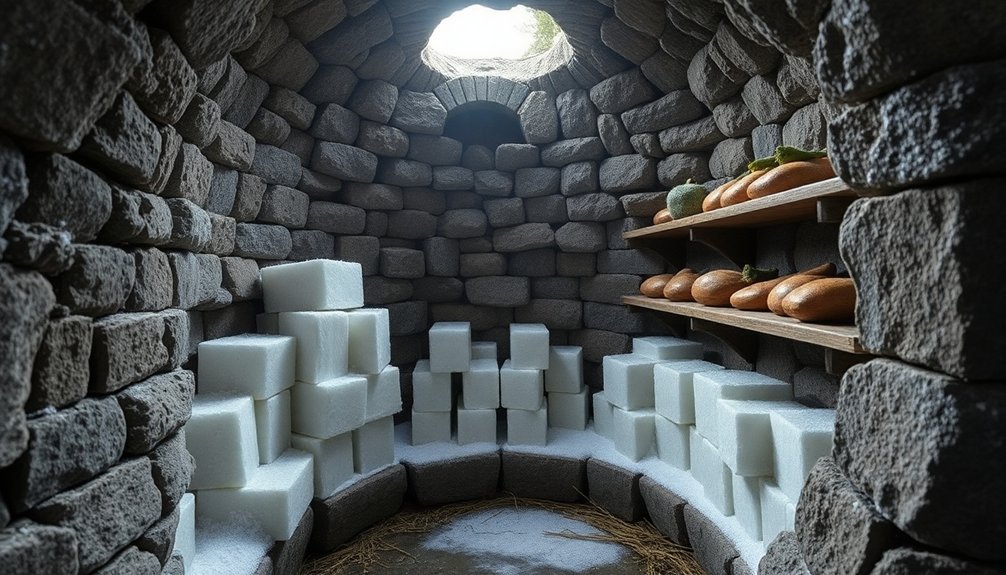
Successful food preservation boils down to four fundamental principles that you'll need to master for year-round storage.
First, you'll want to reduce or eliminate microorganisms by creating environments where bacteria can't thrive. You can accomplish this by removing air and moisture, adjusting temperatures, or adding preservatives like salt, sugar, or acid.
Second, you must prevent food decomposition by controlling the enzymes that cause ripening and spoilage. You'll find that cooling, freezing, and blanching effectively slow down these enzymatic activities.
Third, maintaining ideal storage conditions is essential. You'll need cool, dark spaces like root cellars or proper refrigeration, along with appropriate packaging materials to prevent contamination.
Finally, you'll want to retain nutritional value and texture throughout the preservation process. Different methods affect nutrients differently – freezing generally preserves nutrients better than canning, while freeze-drying retains more vitamins than standard dehydrating.
When you're choosing a preservation method, consider that minimal processing typically helps maintain the food's original qualities. By following these principles, you'll guarantee your stored foods remain safe, nutritious, and enjoyable throughout the year.
Frequently Asked Questions
How Long Can a Typical Ice House Keep Food Frozen?
You'll find that a well-built ice house can keep your food frozen for up to a year, as long as you've properly insulated it with materials like straw or sawdust and packed the ice blocks tightly.
What Happens if Groundwater Leaks Into an Ice House?
If groundwater leaks into your ice house, you'll face serious problems. It'll speed up ice melting, damage the structure's integrity, and ruin insulation materials. Your food storage capabilities will be greatly compromised.
Can Ice Houses Be Effectively Used in Tropical Climates?
You can't effectively use traditional ice houses in tropical climates because high temperatures and humidity would quickly melt the ice. You'd need costly modern cooling systems, making it impractical and environmentally unsustainable.
What's the Average Cost to Build a Traditional Ice House Today?
You'll need to budget between $4,000-$12,500 to build a traditional ice house today, with costs varying based on materials ($1,300-$3,500), labor ($1,000-$3,000), and foundation work ($500-$2,000).
How Many Ice Blocks Are Typically Needed for Year-Round Food Storage?
You'll need approximately 1,300-1,500 ice blocks (60 pounds each) to maintain year-round food storage. This gives you roughly 80,000 pounds of ice, accounting for some melting throughout the warmer months.
In Summary
You've learned how ice houses maintain cold temperatures through a combination of smart design principles and natural physics. From ancient underground chambers to modern adaptations, these structures use earth's constant temperature, proper insulation, and strategic ice placement to keep food fresh year-round. Whether you're exploring historical methods or considering modern applications, ice houses demonstrate how simple, effective cooling solutions don't always need electricity to work.


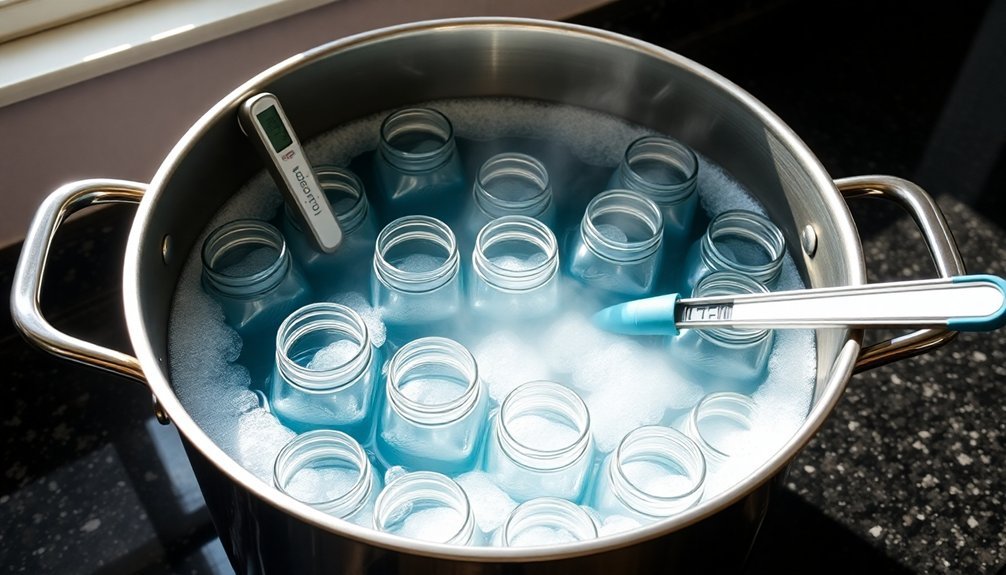
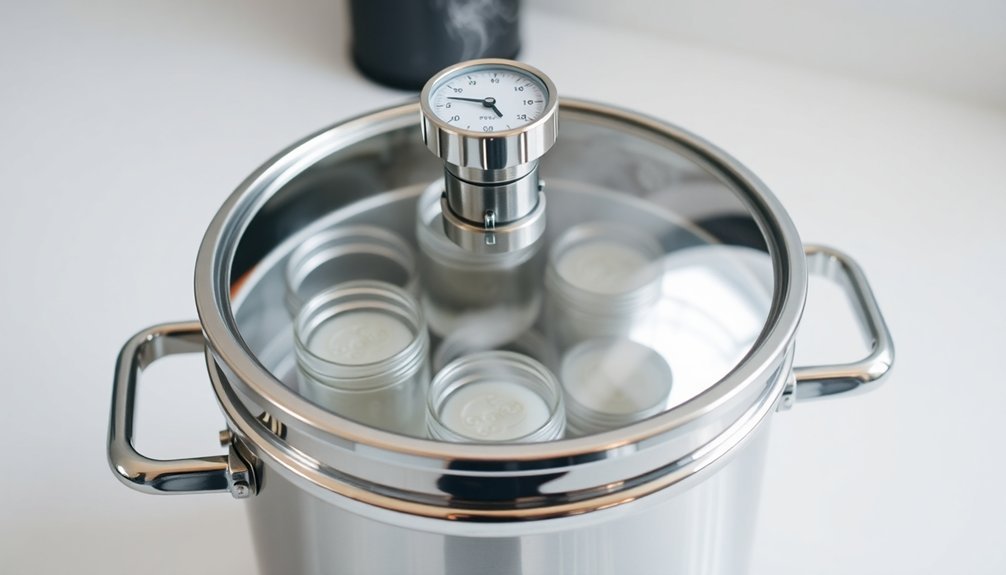

Leave a Reply